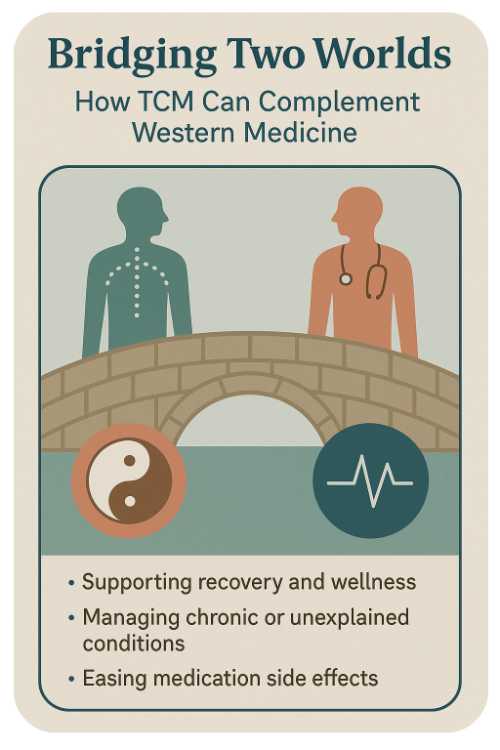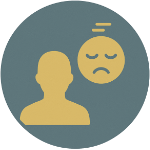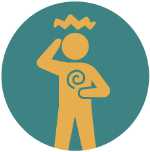Bridging Two Worlds:
How TCM Can Complement Western Medicine
Modern healthcare has made extraordinary advances—from emergency surgery to antibiotic therapy, from diagnostics to pharmaceuticals. Yet for many chronic conditions and long-term wellness, Western medicine can feel incomplete. This is where traditional Chinese medicine (TCM), with its centuries-long emphasis on internal balance, lifestyle, and prevention, offers a valuable complement.
 TCM does not replace Western medicine, nor should it. But used together, these two systems can support a fuller picture of healing—one that addresses both symptoms and root causes, both acute need and long-term health cultivation. Unfortunately, this kind of integration remains rare, and when it does occur, it’s usually the result of patient initiative rather than systemic design.
TCM does not replace Western medicine, nor should it. But used together, these two systems can support a fuller picture of healing—one that addresses both symptoms and root causes, both acute need and long-term health cultivation. Unfortunately, this kind of integration remains rare, and when it does occur, it’s usually the result of patient initiative rather than systemic design.
In most cases, patients who seek TCM do so alongside conventional care. They may take prescribed medication while also practicing Qigong or following dietary guidelines based on the seasons. Acupuncture might be used to ease chemotherapy side effects or chronic pain when medications fall short. Herbal medicine may support digestive recovery after antibiotic use. And perhaps most importantly, TCM offers a framework for understanding the body as an ecosystem—where emotional state, daily rhythm, and environment all shape health outcomes.
While Western medicine excels at treating acute illness, infections, and trauma, it often has less to offer when the problem is diffuse: fatigue without a clear cause, recurring digestive upset, or low-grade anxiety that doesn’t rise to a psychiatric diagnosis. In these cases, TCM offers individualized strategies based on pattern diagnosis, viewing the person in context rather than isolating symptoms.
Scientific research increasingly supports this. Acupuncture has shown benefit in pain management, insomnia, and anxiety. Certain Chinese herbal formulas are being studied for metabolic conditions, immune support, and menopausal symptoms. Even practices like Tuina (therapeutic massage) and Yangsheng (life-nurturing habits) are gaining recognition for their role in stress reduction and improved quality of life.
Still, one of the main barriers to broader integration is the lack of coordination. Western physicians often know little about TCM, and TCM practitioners may not be informed about the patient’s biomedical treatments. Without a common language or shared clinical standards, patients are left to navigate the two systems alone—an imperfect and sometimes risky task.
However, there are hopeful signs. Some hospitals in China already employ both approaches under one roof. In the West, integrative health clinics are emerging, though often in urban centers or academic institutions. And more patients are bringing up their interest in TCM with their doctors, prompting a gradual shift in awareness.
Ultimately, the strength of TCM in this relationship is not in replacing modern care, but in broadening the scope of what healing can mean. It offers tools for self-regulation, for prevention, and for living in harmony with the natural world. It reminds us that health is not merely the absence of disease, but the presence of balance.
For now, the bridge between East and West is still being built—but every thoughtful patient, every open-minded clinician, and every respectful dialogue brings it closer to completion.
Vocabulary
- Qigong (气功 qìgōng) – A traditional system of breath, movement, and awareness used to regulate energy.
- Yangsheng (养生 yǎngshēng) – “Nurturing life”; TCM’s concept of daily practices that support long-term vitality.
- Tuina (推拿 tuīná) – A therapeutic massage technique used in TCM for pain relief and energy regulation.
- Pattern diagnosis (辨证 biànzhèng) – A TCM method of identifying underlying imbalances rather than just labeling symptoms.
- Acupuncture (针灸 zhēnjiǔ) – The insertion of fine needles into specific points to influence the flow of qi and restore balance.





